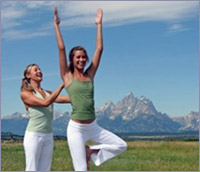How do I start?
 One of the most frequent questions that we receive is how to begin practicing Yoga. We often suggest that you research yoga teachers and centers in your area. TheSecrestOfYoga.com has an extensive list of Yoga teachers and centers from around the world so all you have to do is click on the link below and then click on your location:
One of the most frequent questions that we receive is how to begin practicing Yoga. We often suggest that you research yoga teachers and centers in your area. TheSecrestOfYoga.com has an extensive list of Yoga teachers and centers from around the world so all you have to do is click on the link below and then click on your location:
Once you’ve found a teacher or center in your area, feel free to call or email them with any questions that you may have regarding schedules, prices and so on.
If you’re a novice, I think it’s best to try out different types of yoga, as well as different instructors. You may have a completely different experience with the same form of yoga taught by two different instructors. Once you’ve experimented with two or three different styles of yoga, try practicing the one that you liked best for a period of time.
Which style of yoga should I begin with?
 All forms of Yoga have the same objective: to stimulate and raise the kundalini energy through the spine. Kundalini energy, which we all have, is located in the base of the spine. Through the practice of yoga, the techniques of breathing, and meditation, this energy is stimulated and begins to rise up the spine.
All forms of Yoga have the same objective: to stimulate and raise the kundalini energy through the spine. Kundalini energy, which we all have, is located in the base of the spine. Through the practice of yoga, the techniques of breathing, and meditation, this energy is stimulated and begins to rise up the spine.
In the spine, we find aligned the chakras, or energy centers. Each chakra has different qualities (see Chakras). They are necessary and likewise important. When the kundalini energy rises and begins to cross the different chakras, you will experience higher states of being.
Some forms of yoga accelerate this process more than others, but it also depends on the specific person and their attitude, their flexibility and so on.
Kundalini Yoga
Kundalini yoga is considered to be one of the fastest approaches to raising the kundalini energy. This is in part because all of the classes utilize pranayama (breathing techniques), asanas (positions), meditation and relaxation. This style of yoga is appropriate for all levels.
Kundalini yoga places a great deal of importance on healing. Many sets of yoga are dedicated to the different areas of the body such as the back, heart, liver, kidneys, etc. This style of yoga also influences our emotional side as it eases stress, opens the center of the heart, balances our emotions, combats insomnia, and so forth.
Kundalini Yoga is very musical and involves singing and the recitation of mantras. Music is used during the whole class.
White Tantric Yoga
The practice of White Tantric yoga for one week twice a year during the winter and summer solstices is said to be as powerful as seven years of continuous practice of yoga. For more information visit http://www.whitetantricyoga.com or http://www.3ho.org
Ashtanga Yoga
Ashtanga yoga is a more energetic form of yoga. People who have played sports and are flexible and strong will enjoy this type of yoga quite a bit. With this practice, one acquires great strength, and flexibility.
My personal experience with Ashtanga Yoga is that at the beginning of the class the thoughts are many and constant, but as I start moving through the asanas the thoughts slowly start to decrease, and at the end of the class there are minimized, or gone.
Meditation is not practiced at the end or an Ashtanga yoga class. Patabbhi Jois says “Don’ t think, just practice”, or what is the same, with a continued practice all arrived.
Power Yoga
Power yoga is very similar in practice to Ashtanga yoga. The main difference is that power yoga does not continue the traditional method taught by Pattabhi Jois. Instead, the order of the poses are varied and other poses are added, creating a style that might be described as a modern version of Ashtanga Yoga.
Bikram Yoga
Also known as “Hot Yoga”, Bikram yoga is practiced in a room that is heated to approximately 100 degrees Fahrenheit. Heating the room allows the muscles to relax and prevents muscle injuries. In addition, practicing yoga at this temperature increases physical endurance.
The famous sun salutation is not practiced at the beginning of the class. This may be because the heat warms and opens the body .
There are two things that always caught my attention with Bikram classes. First was the incredible ability of the body to adapt to the high temperatures within two weeks of practice. Second was the fact that the class was almost entirely comprised of men, though I don’t know why.
Hatha Yoga
Hatha yoga is a moderate form of yoga. It is appropriate for all levels.
Almost all the types of Yoga are derived from Hatha Yoga. The poses are all the same. The differences are in how long and how often the poses are practiced, whether or not there are rests between poses, if the room is heated, and so on.
Iyengar Yoga
Iyengar yoga is another form of yoga that is appropriate for all levels. This type of yoga is known for its use of props, like blocks, which help you to perform the poses. It is a very precise form of yoga, which specifically focuses on attaining an ideal alignment of the body. Iyengar continues the eight limbs of yoga as defined by Patanjali (/Ashtanga/The-Eight-Limbs-of-Yoga.html)
Concentration and meditation are a part of Iyengar practice. There are also healing programs designed to address different areas of the body such as the lower back.
Vinyasa Yoga
Vinyasa yoga is an energetic yoga practice. Breathing has an important role and the movement from one pose to another is synchronized with the breathing. A typical class includes “sun salutation” followed by poses of a medium/intense level. This is a very energetic and dynamic yoga practice!
Kripalu Yoga
Kripalu yoga is a moderate practice of yoga appropriate for all levels. The classic poses of Hatha are used along with breathing exercises, or pranayama, to enter a “meditative in movement” state.
Jivamukti Yoga
Jivamukti yoga is an intensely physical form of yoga. Created by David Life & Sharon Gannon, it combines Ashtanga yoga by Pattabhi Jois with Vinyasa yoga. During practice, writings are studied and mantras are recited and sung. It is a very musical form of yoga.
hope this information helps you! The opinions cited here are personal, based on my own experiences and opinions, in hopes of providing the novice with a guide. You will no doubt find other opinions from other people. – Indra K
Yoga Class Etiquette

- Arrive at the class on time. Make sure that you leave enough time to pay and, if necessary, to speak with the instructor about any injuries you may have or instructions you may need. Arriving late distracts the other students as well as the instructor.�
- Take a shower before and after your yoga class.�
- Switch off your mobile phone.
- Remove your shoes and jewellery before the class and place out of the way of mats.
- Do not wear perfumes, whether natural or artificial. This includes essential oils, aftershaves, scented shampoos, and so on. Sweating intensifies the smells and some students can be very sensitive to this.�
- Keep your yoga mat clean.�
- Place your mat according to the dimensions of the class. This helps to the greater utilization of the space.�If there is an empty spot next to you, offer it to another student.
- Do not leave the class during Savasana. If you must leave before the class is finished, do so before Savasana, allowing sufficient time to collect your mat and other belongings and to leave quietly.�
- Do not step on others� mats.�
- Don’t talk or whisper in class. It is distracting to others.
- Make lavatory visits during rest periods; walk around the outside of the class to avoid obstructing other student�s view of the teacher.
- When the class has finished, collect your belongings and return any objects that you may have used such as blankets or blocks.
Things to keep in mind before a Yoga class

- See Yoga Class Etiquette.
- Practice yoga on an empty stomach. You should not anything for two to three hours prior to practice.
- Wear comfortable clothes that do not restrict your movement.
- Do not wear socks during class. There are 72,000 nerves ending in the sole, stimulate them!
- It is better to practice yoga early in the morning before eating and when the mind is free of worries.
- Ideally, you should practice yoga every day. Nevertheless, it is better to practice yoga once or twice a week rather than not practicing at all. Practice should last between 1 and 3 hours.
- If you are menstruating, rest for at least two days during your most intense bleeding. During the rest of your period, avoid practicing inverted poses.
- If you are pregnant or think you may be, be sure to advice your instructor right away. While yoga is very beneficial during pregnancy there are some poses that should be avoided.
- During the first 3 months of pregnancy, avoid energetic movements, as there is a greater risk of miscarriage during these months.
- While yoga can provide healing effects, individuals seeking a cure to a specific illness should practice yoga along with their doctor’s therapy.
- Sweating is part of the practice of yoga. It is way to cleanse the body. Be prepared to sweat. It is believed that wiping sweat with a towel only increases perspiration.
